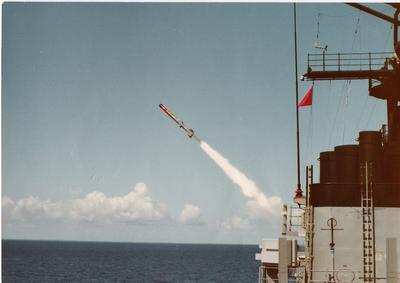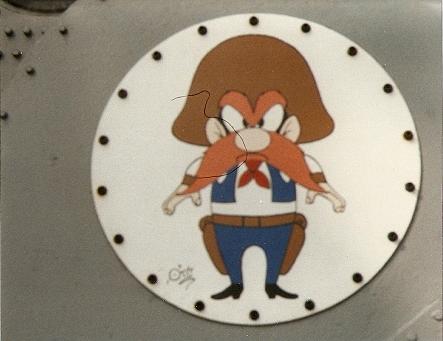I also want to take some time to offer a special salute to the many men who served aboard the U.S.S. Caron (DD 970, pictured left) during her relatively short history. I count it one of the privileges of my life not only to have served with so many fine sailors in the U.S. Navy, but especially to have served aboard the Caron during the Reagan administration and at the height of the Cold War. Here is a brief history of the Caron:
During Caron's more than 20 years of service, she was involved in nearly every conflict that the U.S. had been involved in since her commissioning. Caron was in Grenada, Gulf of Sidra, Beirut, Black Sea, CentAm SpecOps, Gulf War and Haiti. Caron was the first warship to fire Tomahawk missiles in two separate combat engagements when she fired twelve missiles on 17 January 1993, destroying a nuclear weapons development facility outside Baghdad.I served aboard the Caron from 1985-1987, during which time the Lord Jesus saved me and I met my wife, Kim, in Haifa, Israel. So, as you can imagine, the Caron holds special memories for me. In fact, when I heard the U.S. Navy had sunk her after demolitions testing in 2002, I am not ashamed to say that I actually cried.
1974: Laid Down.
1977: Commissioned.
1979: Black Sea Ops with USS McCandless FF-1084. Soviets stage a mock missile attack against Caron.
1983: Operation Urgent Fury. Caron fires 5" guns in combat.
1983-1984: Multi-National Peacekeeping Force Beirut, Lebanon. Caron fires guns in multiple engagements.
1985: Classified Operations in Central America (SpecOps)
1986: Operation Attain Document I, II, III, Operation El Dorado Canyon and Operation Prairie Fire against Libya.
1988: Black Sea Ops. Caron is rammed by Soviet Mikra II Class frigate.
1991: Operation Desert Storm. Fired Tomahawk missiles in engagement with Iraq.
1993: Fired tomahawk missiles in engagement with Iraq.
1993: Enforced UN sanctions against Haiti.
1996: Operation Southern Watch in Persian Gulf.
2001: Decommissioned.
2002: Sunk near Puerto Rico.
The Caron was a very special ship for another reason, though, since she was a spy ship, a fact that meant she was often in dangerous situations, particularly during the Cold War era. In fact, the May 1988 edition of the Bulletin of Atomic Scientists devoted an article to the Caron's role as a spy ship, with a particular focus on her Black Sea operations. Although I don't think the article is fair in its assessment of the Caron's operations in Soviet waters, the article does get the basic facts about her basic configuration, mission, and operations right, as when it states:
The Caron is a specially and uniquely appointed spyship; it is a modern day Pueblo. Its very configuration and mission deny it rights that might be accorded to other ships. Since its commissioning in October 1977, it has been loaded with signals intelligence sensors. It is the Navy's premier ship equipped with the "Classic Outboard" system, which performs over-the-horizon targeting and surveillance. It was the first ship to be equipped with digital computers directly linked to its sonar and other sensors.
Since 1980 the Caron has led 24 intelligence collection missions for the Atlantic Fleet. In 1980-81, the vessel was dispatched above the Arctic Circle and into the Baltic Sea to follow the Kiev aircraft carrier battle group and practice new over-the-horizon targeting and surveillance techniques against the Soviet Union. Besides its latest escapade [referring to the 1988 ramming of the Caron by a Soviet frigate in the Black Sea], the Caron has conducted three other Black Sea surveillance operations [during which I was aboard], including the incident in March 1986 in which it and the U.S.S. Yorktown came within six miles of the Soviet coast.
But the lion's share of the Caron's work has been in the Third World -- off the coast of Central America, in the eastern Mediterranean, and around Libya -- where the ship has conducted 16 separate intelligence missions since 1980. The Caron was the first ship to arrive on station in the Caribbean for operation "Urgent Fury," the 1983 invasion of Grenada. The Caron has spent more time off the coast of Nicaragua than any other U.S. Navy ship since Ronald Reagan took office. In 1981, the Caron was the first ship to track Libyan Fitter fighters reconnoitering U.S. Navy operations. In 1986 the Caron was the first to cross the "line of death" into the Gulf of Sidra before the bombing of Libya.The article then goes on to give a (partial) timeline of the Caron's operations. To give you an idea of the some of the things the Caron was called upon to do, I offer their timeline for the year 1986, during which time I was aboard as part of the Combat Systems Division:
January 1: Caron begins four months of duty in various "Operations in the vicinity of Libya," including Gulf of Sidra operations January 7-February 1 and February 7-17.Although the information that is publicly available is somewhat sketchy, it is clear the type of ship the Caron was and why the many men who served aboard her over the years are so proud to have done so. Especially during the Cold War, the men who served aboard the Caron truly were on the leading edge of America's military providing an invaluable service to their country. The ship's motto was "Vision, Victory, Valor," and her crew always sought to live up to these ideals.
March 10-17: Caron takes time out of Libya surveillance to conduct Black Sea operations with the U.S.S. Yorktown (CG-48), entering on March 10. On March 16 the ships come within six miles of the Crimean Peninsula near Sevastopol. There are three Black Sea deployments in 1986.
March 18: The Soviet Union delivers a note to the U.S. embassy in Moscow protesting the incursion of two U.S. Navy vessels into Soviet territorial waters. A White House spokesman says the vessels were testing the "right of innocent passage," and insists it was not meant to be "provocative or defiant" deployment.
March 22-29: Caron serves as flagship for Destroyer Squadron 20 which leads a three-ship surface-action group to be the first vessel to cross the "line of death" in the Gulf of Sidra.
April 16: Caron ends its operations in the vicinity of Libya.
Here are some photos to help you get a better picture of the Caron.
The photo above shows the Caron "haze gray and underway" in calm seas.
The photo above shows the Caron turning.
The photo above shows the Caron in the Panama Canal, a trip I sadly missed.
The photo above shows a Soviet frigate coming in close to the Caron during Black Sea operations.
The photo above shows the Caron firing an anti-submarine rocket (ASROC) from the launcher mounted on the forecastle (that box-like launcher on the front end of the ship shown in several photos above). My job, as a part of the Anti-Submarine Warfare section of the Combat Systems Division, was to operate and maintain the ASROC launcher.
The photo above shows the Yosemite Sam one of my shipmates painted on the side of our ASROC launcher.
The photo above shows a lifering on the aft end of the ship while underway.
The photo above shows the Caron being used for explosives testing off the coast of Puerto Rico shortly before she was sunk on December 4, 2002.
The two photos above show the Caron in her final moments. What sad pictures!
The photo above shows one of my shipmates, Gary Harvey, who was one of the key men the Lord brought into my life to share the Gospel with me and to lead me to faith in Christ. What a happy picture!













Hello!
ReplyDeleteMy name is Aigars Velveris. I read this article with great interest, because I was in this time in the oppozite site - on board the sowiet submarine S-74 in the Black Sea, March 1986. I was sent the telegram to Black Sea Fleet Headqurtiers about Your sonar AN/SQS53.
I live in Latvia.
Best regards!
Well, I am glad to hear from you, Aigars -- and no longer as an enemy, thank God! I certainly hope your interest in the article extended to my description of the way Lord Jesus graciously saved me from my sins while I was serving aboard the USS Caron, for He can do the same for you if you will turn from your sins and call upon Him in faith. I encourage you to click on the link about how the Lord Jesus saved me in order to find out more. I included the link in the article, but you may also find it in the menu on the right hand side of the blog page.
ReplyDeleteNice that you chose to share the Saturday Night Fever pic I took of Garry! Max Highbaugh
ReplyDelete